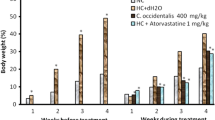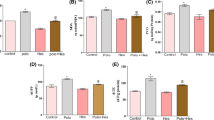Abstract
Statins have been widely used in the treatment of hypercholesterolemia and atherosclerotic disease. Atherosclerosis is an ongoing inflammatory response which is involved in mediating all stages of this multifactorial disease. The present study focuses on the long term effect of atorvastatin on the anti-atherogenic and anti-inflammatory properties with reference to para-oxonase and C-reactive protein levels in rats. Thirty six Wistar albino rats obtained from the central animal house were divided into 6 groups with 6 rats in each group. Group I and IV served as the control for male and female rats respectively. Group II and V comprised of male and female rats that received low dose of atorvastatin (10 mg/kg body weight). Group III and VI comprised of male and female rats that received high dose of atorvastatin (40 mg/kg body weight) for period of 45 days. Blood was collected by cardiac puncture. The plasma was analysed for total cholesterol, HDL cholesterol, C-reactive protein (CRP) and Paraoxonase-1, both basal Paraoxonase (BPON) & Salt stimulated Paraoxonase (SPON) by standard procedures. Results of the present study showed a reduction in TC and increase in HDL-C in both groups of rats receiving low and high dose of Atorvastatin. Both male and female rats responded similarly. The levels of CRP decreased in the male rats receiving either low or high dose of atorvastatin. Activity of SPON and BPON was increased only in the group receiving high dose of atorvastatin in both male and female rats.

Similar content being viewed by others
References
Libby P, Ridker PM, Maseri A. Inflammation and atherosclerosis. Circulation. 2002;105:1135–43.
Ferretti G, Bacchetti T, Moroni C, Savino S, Liuzzi A, Balzola F. Paraoxonase activity in high-density lipoproteins: a comparison between healthy and obese females. J Clin Endocrinol Metab. 2005;90:1728–33.
Aviram M, Rosenbalt M, Biasgaier CH, Newton RS, Primo-Parmo SL. Paraoxonase inhibits high density lipoprotein oxidation and preserves its functions. A possible peroxidative role for paroxonase. Clin Invest. 1998;101:1581–91.
Corti R, Fuster V, Fayad ZA, Worthley SG, Helft G, Smith D. Lipid lowering by simvastatin induces regression of human atherosclerotic lesions: two years follow-up by high-resolution noninvasive magnetic resonance imaging. Circulation. 2002;106:2884–7.
Durrington PN, Mackness B, Mcknesss MI. Paraoxanase and atherosclerosis. Atheroscler Thromb Vasc Biol. 2011;21:473–80.
Aronow WS. Hypercholesterolemia: the evidence supports use of statins. Geriatrics. 2003;58(8):18–20.
Aronow WS. Cholesterol: rationale for lipid-lowering in older patients with or without CAD. Geriatrics. 2001;56(9):22–5.
Delbosc S, Cristol J-P, Descomps B, Mimran A, Jover B. Hypertension, simvastatin prevents angiotensin II—induced cardiac alteration and oxidative stress. Hypertension. 2002;40:142–7.
Corti R, Fayad ZA, Fuster V, Worthley SG, Helft G, Smith D. Effects of lipid-lowering by simvastatin on human atherosclerotic lesions: a longitudinal study by high resolution, noninvasive magnetic resonance imaging. Circulation. 2001;104:249–52.
Bruckert E, Hayem G, Dejager S. Mild to moderate muscular symptoms with high-dosage statin therapy in hyperlipidemic patients—the PRIMO study. Cardiovasc Drugs Ther. 2005;19:403–14.
Sattar N, Preiss D, Murray H, Welsh P. Statins and risk of incident diabetes: a collaborative meta-analysis of randomised statin trials. Lancet. 2010;375:735–42.
Ridker PM, Hennekens CH, Buring JE. C-reactive protein and other markers of inflammation in the prediction of cardiovascular disease in Women. N Engl J Med. 2000;342:836–43.
Meiattini F, Prencipe L, Bardelli F, Giannini G, Tarli P. The 4-hydroxybenzoate/4-aminophenazone Chromogenic system used in the enzymatic determination of serum cholesterol. Clin Chem. 1978;4:2161–5.
Burstein M, Schonick HP, Morfin R. Cholesterol in high density lipoprotein using magnesium and phosphotungstic acid. J Lipid Res. 1978;19:583.
Rifal N, Tracy RP, Ridker PM. Clinical efficacy of an automated high sensitivity C-reactive protein. Clin Chem. 1999;45(12):2136–41.
Gan KN, Smolen A, Eckernon HW, La Du BN. Purification of human serum paraoxonase/arylesterase. Evidence for one ester catalyzing both activities. Drug Metlab Dispos. 1991;19:100–6.
Adekunle AS, Bukoye OE. Assessment of anti-inflamatory activity of statin. Int J Pharm Pharm Sci. 2013;5(3):203–5.
Masatoshi F, Tatsuya M, Masaki I, Mayu T, Akiko I, Miwa K. Dose dependency in pleiotropic effects of atorvastatin. Int J Anquiol. 2007;16(3):89–91.
Rosenson RS, Koenig W. Utility of Inflammatory markers in the management of Coronary artery disease. Am J Cardiol. 2003;92:10i–8i.
Tekin A, Tekin G. Effects of atorvastatin on hemostatic and inflammatory parameters in hyperlipidemic patients with angiographically proven coronary artery disease. Am J Cardiol. 2004;94:206–9.
Aviram M, Sorenson R. Paraoxonase active site required for protection against LDL oxidation involves its free sulfhydryl group and is different from that required for its Paraoxonase activities: selective active of human paraoxonase alloenzyme Q and R. Arterioscler Thromb Vasc Biol. 1998;10:1617–24.
Mackness MI, Mackness B, Hegele RA. Paraoxonase: biochemistry, genetics and relationship to plasma lipoprotein. Curr Opin Lipidol. 1996;7:69–76.
Mackness MI, Hennuyer M, Durrington PN. Paraoxonase activity is reduced by a pro atherosclerotic diet in rabbits. Biochem Biophys Res Commun. 2000;269:232–6.
Sutherland WHF, Walker RJ, de Jong SA, van Rij AM, Phillips V, Walker HL. Reduced postprandial serum paraoxonase activity after a meal rich in used cooking fat. Arterioscler Thromb Vasc Biol. 1999;19:1340–7.
Van der Gaag MS, van Tol A, Scheek LM, James RW, Urgert R, Schaafsma G, et al. Daily moderate alcohol consumption increases serum paraoxonase activity: a diet-controlled, randomised intervention study in middle-aged men. Atherosclerosis. 1999;147:405–10.
Van Lenten BJ, Hama SY, De Beer FC, Stafforini DM, McIntyre TM, Prescott SM, et al. Anti-inflammatory HDL becomes pro-inflammatory during the acute phase response. J Clin Invest. 1995;96:2758–67.
Feingold KR, Memon RA, Moser AH, Grunfeld C. Paraoxonase activity in the serum and hepatic mRNA levels decrease during the acute phase response. Atherosclerosis. 1998;139:307–15.
Hedrick CC, Hassan K, Hough GP, Yoo J, Simzar S, Quinto CR. Short-term feeding of atherogenic diet to mice results in reduction of HDL and paraoxonase that may be mediated by an immune mechanism. Arterioscler Thromb Vasc Biol. 2000;20:1946–52.
Aviram M, Rosenblat M, Bisgaier CL, Newton RS. Atorvastatin and gemfibrozil metabolites, but not the parent drugs are potent antioxidant against lipoprotein oxidation. Atherosclerosis. 1998;138:271–80.
Paragh G, Balogh Z, Seres I, Harangi M, Boda J, Kovacs P. Effect of gemfibrozil on HDL-associated serum paraoxonase activity and lipoprotein profile in patients with hyperlipidaemia. Clin Drug Invest. 2000;19:277–82.
Zhao Y, Ma Y, Fang Y, Liu L, Wu S, Fu D. Association between PON1 activity and coronary heart disease risk: a meta-analysis based on 43 studies. Mol Genet Metab. 2012;105:141–8.
Author information
Authors and Affiliations
Corresponding author
Ethics declarations
Conflict of interest
All authors declare that they have no conflicts of interest.
Rights and permissions
About this article
Cite this article
Marathe, A., Ganaraja, B., Ashwin Shenoy, K. et al. Effect of Atorvastatin on Serum Para-Oxonase-1 and C-Reactive Protein in Wistar Rats. Ind J Clin Biochem 34, 312–317 (2019). https://doi.org/10.1007/s12291-018-0742-1
Received:
Accepted:
Published:
Issue Date:
DOI: https://doi.org/10.1007/s12291-018-0742-1




